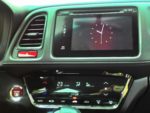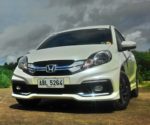 “I BECAME fascinated by airplanes and wanted to make them, so I studied airplanes in college. But back when I graduated, Japan wasn’t allowed to make airplanes. So I channeled my dream into racing instead and joined Honda.
“I BECAME fascinated by airplanes and wanted to make them, so I studied airplanes in college. But back when I graduated, Japan wasn’t allowed to make airplanes. So I channeled my dream into racing instead and joined Honda.
“At first, it was motorbike racing. When we were winning one race after another, I learned that Honda was going to try its hand at F1 racing, and I nearly jumped up and down with joy.
“My dream turned from motorbikes to F1 cars. I plunged headlong into it, and after much effort, we were able to get to the top of the winners’ podium. We put our knowledge to use in our passenger cars, and Honda became world-class not just in motorbikes but in automobiles, too.
“A dream will always come true if it’s focused, and if you strive after it. It’s because you have a dream that you can try so hard.”
—Shoichiro Iramajiri, “The Prince of Honda,” as quoted by auto journalist Masaaki Sato, author of “The Honda Myth, The Genius and His Wake.”
Iramijiri, a talented engineer who oversaw Honda’s first US car manufacturing factory in Ohio, left Honda at the age of 52, but his vision continues.
He is considered one of the heroes of Honda. Of course, the vision and insights of co-founders Soichiro Honda and Takeo Fujisawa continue to live on, and are reflected in each car that rolls out the Honda assembly.
Iramajiri’s passion is reflected in the carmaker’s versatility, showing its expertise in the design and engineering in virtually all vehicle types.
Honda was the world’s most prolific builder of motorcycles when it decided in the early 1960s that it would enter the car business.
According to auto journalist Tony Lewin, right from the start, its four-wheeled products were different from those of its competitors in Japan and abroad.
It is in its niche models, however, that Honda has produced its most memorable designs and innovations.
Inquirer Motoring recently had the chance to drive two of these niche vehicles: the Honda’s HR-V (which looks much like a Jazz on stilts), and the 7-seater practical family vehicle Mobilio.
If you’re a loyal Honda owner, consider these two vehicles for your future second or third automobiles.
As its maker claims, the HR-V is built for discerning drivers who live well-rounded lifestyles. It combines the toughness of an SUV, the feel of a coupé, and the functionality of a minivan.
 The HR-V has smart, user-friendly features and made for young professionals who live, and make a living, in the concrete jungles and in the outdoors.
The HR-V has smart, user-friendly features and made for young professionals who live, and make a living, in the concrete jungles and in the outdoors.
The Mobilio, on the other hand, is Honda’s practical 7-seater MUV (multipurpose utility vehicle).
Inquirer Motoring drove the Honda Mobilio 1.5 RS Navi CVT twice. The first one—in 2015—being the most memorable because we put this through punishing paces, not only on the Manila-Vigan route, but with a subsequent trip northward to Ilocos Norte, then back to Manila during monsoon rains.
HR-V drive impressions
 1. It looks like a compact version of the CR-V, but at the same time looks like sedan with a higher clearance, achieving the perfect compact urban crossover look.
1. It looks like a compact version of the CR-V, but at the same time looks like sedan with a higher clearance, achieving the perfect compact urban crossover look.
The front carries elements of the CR-V, while the rear hints of the Jazz. The side appearance highlights the unusually placed rear door hinges located high beside the rear window.
2. You can tell right away, upon entering the cockpit, that the HR-V was made for the younger set. Perhaps those about to finish college, or the young urban professionals.
Virtually the entire central console instrumentations (infotainment, climate controls) are touchscreen. The dashboard indicators (speed, rpm, etc.) also emanate a nice “3D effect.”
3. On Economy mode (when the green leaf icon light beside the tachometer is on), the engine really makes you feel that it’s conserving fuel.
 The pedal-to-street acceleration is noticeably repressed, making the body feel heavy. But when it does reach cruising speeds (80 to 100 kph), it stays there within the frugal 1,800 to 2,000 rpm range.
The pedal-to-street acceleration is noticeably repressed, making the body feel heavy. But when it does reach cruising speeds (80 to 100 kph), it stays there within the frugal 1,800 to 2,000 rpm range.
Of course, everything changes when you shift to the Sport mode. The green light is off, and with paddle shifters at your disposal, the HR-V is on beast mode.
4. It has leg room and butt space for three passengers at the back, and lots of storage space. A longer test drive is needed for those seriously considering seat comfort for the back passengers.
5. Honda being a Honda, the price of the HR-V (which starts at P1.238 million) is quite “up there” with the upper crust of its market.
This merely continues Honda’s image of prestige in all its segments, and now continues with its entry in the compact crossover market.
6. Notable are: a) exterior design – Honda uncannily combines the visual qualities of the Jazz, CR-V, and even some subtle hints of its sedan lines into the HR-V; b) interior – for the “millennial” cockpit, non-leather seats (which also means no animals were harmed in the creation of these seats), and a versatile rear seating configuration that can transform the HR-V interior into a classy yet fun outdoor vehicle that can carry all the stuff that you need so you feel alive outside the concrete jungles; c) ride performance – offers a range of driving modes, from Eco (which yielded 8 km/liter in city traffic), to Sport, and then the paddle shifters.
Mobilio ride impressions
1. Space, in a compact package. It’s like a paradox. One can’t have that much space for seven individuals if your vehicle is classified as a compact, right?
But the Mobilio is a wizard in space management, and it was proven when my passengers slept like babies during this long road trip. It looks small on the outside, but inside you can really stretch.
2. Flexible and versatile seat configurations. By the time we were going back to Manila, we had lugged more items than coming in, so it was necessary to re-configure some seating and luggage arrangements.
Happily, the Mobilio was flexible enough to give us options: we could go for a full seven-seater layout and still get large cargo space (223-liter trunk capacity), or we could tumble-fold the third row and get 470 liters of cargo space, or we could totally fold the third row and get a 521 liters of cargo space.
The light and tumble seats make it easy for the passengers to get into the rearmost, especially when we had to hop hurriedly from one tourist spot to the next so the rains wouldn’t catch up on us.
The second row seats split 60:40, and the third row is split 50:50, with both rows reclining. The one-touch fold-to-tumble function allows wider room for easier and faster passenger ingress and egress.
3. Comfortable inside. The noise, vibration and harshness insulation of the Mobilio is admirable, shielding us from the wrath of the wettest forces of nature.
Even when the coastal highway provided no illumination along the tricky, twisty sections at night, the Mobilio’s halogen headlights, fog lights, rear wiper with washer and rear defogger kept the road visible.
4. Engine performance. My experience on the twists and mountain passes proved that the Mobilio, even when fully loaded, was powerful, and still managed to be fuel efficient.
The Mobilio I drove is powered by a 1.5-liter i-VTEC engine mated to the Continuous Variable Transmission (maximum power 118.36 hp at 6,600 revolutions per minute; max torque of 145 Nm at 4,600 rpm)—the first engine-transmission combination in the S-MUV (small multipurpose utility vehicle) segment.
The CVT is responsible for better fuel efficiency, less engine stress, elimination of shift shock and lag, and that sporty performance.
The Mobilio generates the best engine power in its class at 118.36 hp. And yet, despite the flooded conditions, extended traffic, and weight of my passengers and cargo during my North Luzon trip last year, the Mobilio still yielded 17 km/liter during the trip from Manila to Vigan.
When, alone in the Mobilio, I did a run from Tagaytay City down to Bacoor in Cavite, the Mobilio’s fuel efficiency meter topped the scales at 36 km/liter.
Such efficiencies could be achieved with the help of its Eco lamp, which lights up green when the driver is in the optimum zone of fuel efficiency.
A Mobilio drive a few weeks ago yielded a 9.2 km/liter (city drive) to 25.8 km/liter (highway run).
5. Laden with technology. Keeping me awake and entertained when stuck in traffic was the 7-inch touch screen with built-in navigation and emergency hotline buttons and audio system, the controls for which were conveniently placed on the steering wheel (in both RS and V variants).
Other convenient tech touches are the keyless entry, and rear air-conditioner with independent controls.
6. Safety features. The dual SRS airbags, antilock braking system with electronic brake force distribution, the G-Con, Isofix (provides standardized anchoring points for the child safety seat), high mount stop lamp, driver seatbelt reminder, and immobilizer definitely added to a reassuring ride.
7. The Euro 4 advantage. Honda Cars Philippines Inc. (HCPI) announced that its automobiles, including the Mobilio, are Euro 4-certified.
A vehicle certified to be Euro 4 means it has been able to significantly reduce the amount of pollutants it emits into the environment, helping ensure the quality of breathable air.
As early as 2004, HCPI started introducing Euro 4-ready products in the Philippine market. By the end of 2006, all HCPI automobiles sold in the Philippines were already at par with Euro 4 emission levels.
The Mobilio price starts at P817,000.
I do urge you to test-drive the HR-V. Bring along your passengers. The Mobilio should be experienced with the whole family in tow. Check out the complete specifications of the two vehicles at www.hondaphil.com.
Disclaimer: The comments uploaded on this site do not necessarily represent or reflect the views of management and owner of Cebudailynews. We reserve the right to exclude comments that we deem to be inconsistent with our editorial standards.














